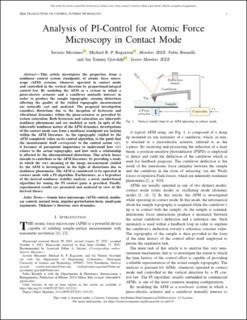| dc.contributor.author | Messineo, Saverio | |
| dc.contributor.author | Ragazzon, Michael Remo Palmén | |
| dc.contributor.author | Busnelli, Fabio | |
| dc.contributor.author | Gravdahl, Jan Tommy | |
| dc.date.accessioned | 2022-04-20T07:53:16Z | |
| dc.date.available | 2022-04-20T07:53:16Z | |
| dc.date.created | 2021-11-03T12:14:27Z | |
| dc.date.issued | 2021 | |
| dc.identifier.citation | IEEE Transactions on Control Systems Technology. 2021, . | en_US |
| dc.identifier.issn | 1063-6536 | |
| dc.identifier.uri | https://hdl.handle.net/11250/2991501 | |
| dc.description.abstract | This article investigates the properties, from a nonlinear control system standpoint, of atomic force microscope (AFM) systems, whenever operated in contact mode and controlled in the vertical direction by proportional-integral control law. By modeling the AFM as a system in which a piezo-electric actuator and a cantilever mutually interact in order to produce the sample topography, ensuing distortions affecting the quality of the yielded topography measurement are naturally cast and analyzed. The proposed investigation considers distortions due to the inception of hysteresis and vibrational dynamics within the piezo-actuator or provoked by system saturation. Both hysteresis and saturation are inherently nonlinear phenomena and are modeled as such. In spite of the inherently nonlinear nature of the AFM dynamics, investigations of the contact mode case from a nonlinear standpoint are lacking within the AFM literature. As the topography yielded by the AFM completely relies on its control algorithm, to the point that the measurement itself corresponds to the control action v(t), it becomes of paramount importance to understand how v(t) relates to the actual topography, and how such a relationship is affected by the aforementioned distortions. This article hence intends to contribute to the AFM literature, by providing a study in which the very meaning of the image measurement yielded by the AFM is investigated, in the light of distortions due to nonlinear phenomena. The AFM is considered to be operated in contact mode with a PI algorithm. Furthermore, as a byproduct of the derived nonlinear stability analysis, a novel, model-based algorithm for tuning the PI control gains is provided. Finally, experimental results are presented and analyzed in view of the derived theory. | en_US |
| dc.language.iso | eng | en_US |
| dc.publisher | Institute of Electrical and Electronics Engineers (IEEE) | en_US |
| dc.rights | Navngivelse 4.0 Internasjonal | * |
| dc.rights.uri | http://creativecommons.org/licenses/by/4.0/deed.no | * |
| dc.title | Analysis of PI-Control for Atomic Force Microscopy in Contact Mode | en_US |
| dc.type | Peer reviewed | en_US |
| dc.type | Journal article | en_US |
| dc.description.version | publishedVersion | en_US |
| dc.source.pagenumber | 15 | en_US |
| dc.source.journal | IEEE Transactions on Control Systems Technology | en_US |
| dc.identifier.doi | 10.1109/TCST.2021.3121321 | |
| dc.identifier.cristin | 1950971 | |
| cristin.ispublished | true | |
| cristin.fulltext | original | |
| cristin.qualitycode | 2 | |

